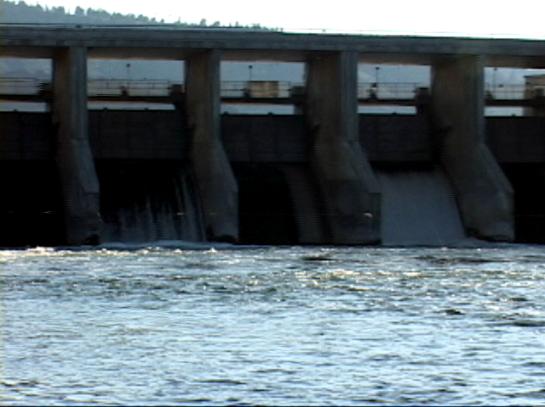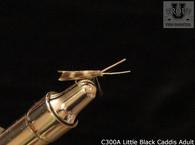
The Bighorn River, named after the famous big horn sheep, is a tributary of the Yellowstone River and is approximately 460 miles long. The Bighorn starts near the town of Thernoplis, Wyoming at the Boysen Reservoir and flows into Montana and through the Bighorn Lake formed by the Yellowtail Dam. Then the Bighorn is joined by the Little Bighorn before it meets up with the Yellowstone River near the town of Bighorn, Montana.
The Bighorn River is nationally recognized as one of the best trout fishing destination in the United States with estimated ranging from 3,000 to 5,000 fish per mile. It is said that the brown trout average about 15 inches and that the rainbows average even more. The Bighorn is a quality fishery throughout the entire year. Fishing the Bighorn usually is considered to be best for the first 13 miles below the Yellowtail Afterbay Dam and before the Bighorn Access Site. The water leaving the dam is regulated for irrigation and as such provides an even flow of cold water creating an excellent habitat for trout.
The Bighorn in this section is wide averaging forty to sixty yards flows through an open and somewhat isolated landscape. Few trees are found except along the riverbanks which are covered with grass, cotton wood trees and brush. It flows through the Bighorn Canyon National Recreational Area for twenty miles.
Between the Bighorn Access Site and the Two Leggins Site the temperature of the water increases but the trout fishing is still very good especially for the brown trout. Below Two Leggins, you will still find brown trout but the numbers will not be as great. Below St. Xavier Access Site, the Bighorn River enters the Crow Indian Reservation, where it flows for another fifteen miles. A special tribal fishing license is not needed to fish the river in the Crow Reservation. There is no shore access for this stretch, so plan of a floatation trip if you want to fish this section. The lower Bighorn becomes too warm for trout however the small mouth bass fishing is rewarding.
Fly Fishing the Bighorn River:
The Bighorn River fishes well for both wading anglers and floating, however, float fishermen will have the advantage of being able to easily go from one prime location to another prime location. Also they will be able to cover the great width of the Bighorn more easily. The river can be floated all the way from the dam at Ft. Smith and floaters will enjoy the numerous put in and take out points along the Bighorn.
The Bighorn supports prolific hatches of blue winged olives, tricos, pale morning duns, caddis and stoneflies. But these trout have seen many imitations of aquatic insects and they will not be impressed with a poorly tied pattern or by a poor presentation.
As you might guess, the 13 mile stretch of the Bighorn will see a great deal of fishing activity during the summer months. It is not uncommon to see several dozen of rafts and several more anglers fishing from the banks on any one day.
Fly Fishing The Bighorn in Spring:
The blue winged olives will start hatching in April, and they will occur most frequently in the mid day. Dry flies in the smaller hook sizes will work well and for the nymphs use a hook size of 16 to 20.
Fly Fishing The Bighorn in Summer:
The summer months will see the most anglers on the Bighorn. The water remains cool below the dam for the first several miles provides great fishing during the peak of summer. The little yellow stonefly hatch will start in July and will provide plenty of action for patterns in the 16 to 18 hook sizes. The excellent hatches of the pale morning duns will be underway and will continue through August as well. These hatches will be at their best during the middle of the day. Use dry fly patterns in the 14 to 18 hook sizes and present them in a drag free drift. When using the nymph patterns choose hook sizes 16 to 20. A typical rig is 2 flies, tied approx. 1' apart on 3-4x tippet, in a 9' leader, with split shot added around a foot above the top fly. A strike indicator is added about 4'-7' above the lowest fly.
Also, summer brings grasshoppers, and fishing hoppers to the big browns near the banks is about as fun as it can get.
Fly Fishing The Bighorn in Fall:
Late summer has several hatches and is probably the best time to fish the Bighorn. Look for the great black caddis hatch to start in August and continue through September. These hatches are the heaviest in the evenings and hook sizes of 14 to 18 are recommended.
The tricos will come off the water in the evenings and return to lay their eggs in the morning. Despite their tiny size, they can be spotted as swarms of flies and they provide a staple in the trout’s diet. Use light tipper (6X or 7X and small hook sizes of 20 to 24.
Winter:
Fly fishing the Bighorn River is good throughout the winter and midges will be the fly of choice. Use patterns in the hook sizes of 18 to 24 and fish them as a dead drift in slower water. Be sure to get them on the bottom or as near as possible. The red and tan nymphs will prove to be the best colors. Also, do not forget to have some streamers handy as they are productive as well.
There are 2 access spots near Ft. Smith where fisherman can "walk-in". One is at the Afterbay, and the other is 3 Mile (3 miles downstream from Ft. Smith. Three Mile is the best. A parking sticker obtainable from the National Parks is required to park ($5.00 per day) Because the Bighorn is pretty much surround by the Crow Reservation, access is limited and a boat is the best option. Care must taken to avoid the dams and to not trespass.
Fly Fishing for Trout in Tailwaters
Fly Fishing Strategies That Catch Trout
Mayflies-Fly Fishing Guide to Imitating Aquatic Insects
Great original artwork is recommended by our artist friend and fishing guide David McDougall.





